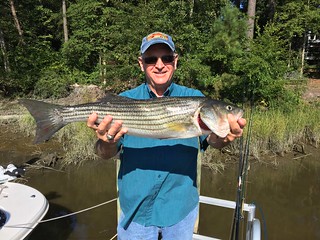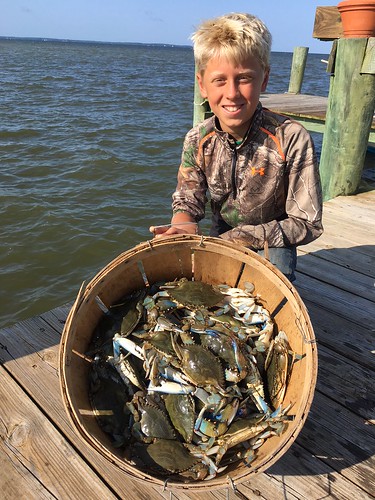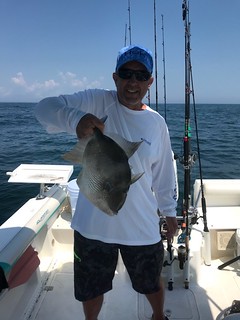Maryland Fishing Report: August 29
Labor Day weekend approaches and many of us are wondering, “How did we get here so soon?”
The kids will be going back to school and we will slowly start to see cooler temperatures in September. If you’re trying to fit in some family fishing time, remember who your audience is – kids just want to have fun. They will enjoy the action fishing for bluegill sunfish in a local pond or for white perch in a nearby tidal river. Leave your own fishing rod at home and give them your full attention, and just enjoy the smiles.
Forecast Summary: Aug. 29-Sept. 4
Chesapeake Bay anglers will need plenty of sunscreen and cold drinks for the next few days as a result of hot, sunny and calm weather conditions. After Thursday, a new weather system will roll through with more chances for thunderstorms and slightly cooler weather.
Upper bay water clarity is still reduced from the elevated river flows from the Susquehanna down to Swan Point. In addition, algal blooms are beginning to appear in the lower bay from near Hooper’s Island down to the mouth of the Potomac River.
At the National Oceanic and Atmospheric Administration buoys, daytime water temperatures are warm – Annapolis at 83 degrees, Gooses Reef at 85 degrees and Point Lookout at 84 degrees – and expect surface water temperatures to rise even higher through Thursday. The coolest waters continue to be located from the Susquehanna Flats down to the Still Pond area, and deeper waters from Swan Point south down to the Virginia line. Maryland Department of Natural Resources monitoring data shows adequate oxygen from surface down to about 23 feet from Swan Point down to the Bay Bridge, 15 feet at Bloody Point, and more than 30 feet from the mouth of the Choptank River down to the state line.
Anglers should continue to seek the best combination of clear, cool, oxygenated waters. This means fishing deeper during the day or early in the morning during moving water in the shallows when surface water temperatures can be about 3 degrees cooler. There will be above average tidal currents through Saturday as a result of the full moon that occurred this past weekend.
For the full weekly fishing conditions summary and more detailed fishing conditions in your area, please be sure to check out Eyes on the Bay’s Click Before You Cast.
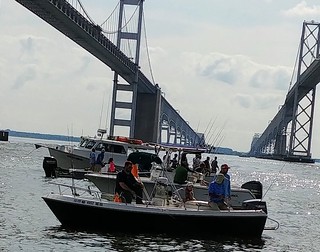
This group was stationed at the Bay Bridge Sunday, drifting spot down-current to the bridge piers. Photo by Rich Watts
Water releases from the Conowingo Dam are still far above average for this time of the year, causing stained waters in the upper bay and leaving some floating wood debris in the region. Fishing has been good with chumming and live lining spot being two of the more popular ways to fish for striped bass.
The striped bass tend to be on the move from one location to another in a short span of time. Swan, Love and Podickory points as well as the Bay Bridge have been the four key locations to look for suspended fish. The striped bass tend to be holding in about 20 feet of water, and although chumming is still effective, live lining spot has been the most popular way to fish. This past Friday at Podickory Point, boats with live-lining anglers were gunwale to gunwale.
Spot are readily available in some of the shallower areas of the upper bay that have hard bottoms of oyster shell or sand. The mouths of the Magothy and Chester rivers have been good places to fish for spot in about 15 feet of water. The west side of the Bay Bridge is another good place to catch spot. Pieces of bloodworm on a bottom rig and a live well will do the job for providing lively baits.
Fishing for white perch remains very good. Using bait on a bottom rig in deeper waters tends to be the most popular way to catch them due to stained waters and warmer shallow areas. Pieces of bloodworms are a mainstay but if you can catch some grass shrimp with a fine mesh net in shallow grass or encrusted bulkheads, your wallet will thank you and the perch love them. Grass shrimp are best fished close to structure such as dock piers. Channel catfish can be found in all of the regions tidal rivers and out in the bay; cut bait often makes the choice for bait. Flathead catfish can be caught in the lower Susquehanna on fresh caught bait.
Below the Bay Bridge, fishing for striped bass continues to improve as oxygen levels elevate at depths down to 25 feet in many areas along channel edges. At the outside edge of Hacketts Bar there are striped bass holding at about 20 feet. The channel edges of the False Channel, the Diamonds, Thomas Point and edges at the mouths of major tidal rivers are also holding striped bass. Live lining spot at these locations has been the most popular way to fish, with chumming a distant second.
Spot can be found in Whitehall Bay behind Hacketts Bar, Eastern Bay, the Choptank River and the western shore tidal rivers on hard bottom in about 15 feet of water. White perch will also be found in these same areas and make for some good eating.
The waters remain stained this week and boaters will see floating marine debris at times. Salinity values are extremely low for this time of the year. This fact may keep the movement of Spanish mackerel to the lower bay and so far there have only been sparse reports of bluefish in the region.
The shallow water fishery for striped bass remains an early morning venture for those that can get out on the water before dawn. Casting with light tackle gear near prominent points and shoreline structure with topwater lures, swimbaits or jerkbaits has been effective.
Fishing for white perch has been very good, with the best catches coming from waters 10 feet or deeper due to warm surface water temperatures. Small jigs baited with a piece of bloodworm or a grass shrimp is a great way to fish for them around docks and piers. A simple bottom rig baited with the same is another good way to fish and can be used over more open waters on oyster bottom.
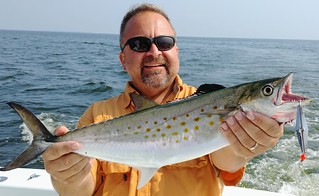
Ted Kolobow proudly holds up a nice Spanish mackerel caught on a Clark spoon. Photo courtesy of Ted Kolobow
Perhaps the most exciting action going on in the lower bay is the catch-and-release fishery for large red drum in the area of the Middle Grounds to north of the Target Ship. At times the drum are pushing small bluefish to the surface which makes for some exciting action for those casting anything from jigs and spoons to topwater lures. Spanish mackerel can also be found in this surface action at times trying to feed on baitfish, but are being pursued themselves by the red drum.
Trolling a mix of red and green hoses and spoons along the shipping channel edges and the mouth of the Potomac has been accounting for some bluefish, Spanish mackerel and a few striped bass. It also pays to pull some larger spoons in the hope of enticing a strike from a large red drum or perhaps a wandering cobia.
Live lining spot has been the most popular way to fish for striped bass. The spot are readily available at a number of locations and the striped bass are eager to take them when they are sent down to about 20 feet along channel edges. The steep channel edges near St. Georges Island and St. Clements are good places to live line spot.
The mouth of the Wicomico and St. Mary’s rivers in the lower Potomac are good places to catch them in about 15 feet of water. Cornfield Harbor and the mouth of the Patuxent River are two other excellent places to catch them on the western shore. Some of the spot are large enough to eat and make great table fare. Croaker and white perch can also be part of the mix when bottom fishing.
Bottom fishing is excellent this week on the eastern side of the bay in Tangier and Pocomoke sounds. Most are using a mix of peeler crab, spot and shrimp for bait and catching a bountiful mix of spot, croaker, white perch and small bluefish. Breaking fish can be seen at times in the area and are usually bluefish and Spanish mackerel chasing bait. Sometimes striped bass can be found underneath by jigging and large red drum may come along at any time.
Recreational crabbing has taken a welcome swing in a positive direction as more crabs enter the fishery. Catches are up in all regions of the bay with the best catches coming from the middle and lower bay. Fresh chicken necks have been good bait but if one can deal with mesh bags and snoots, razor clams are accounting for the best catches. Terrapin turtles and cownose rays are also attracted to razor clams and have a habit of tearing up bags.
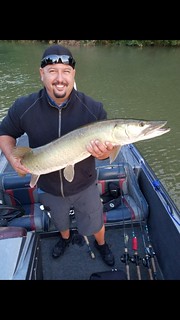
Kevin Willingham was fishing for smallmouth bass when he caught and released this muskellunge. The muskie is suspected to have come from the Conowingo Reservoir through the dam’s turbines or flood gates. Photo courtesy of Kevin Willingham
It will be a busy Labor Day weekend at Deep Creek Lake in regards to boat traffic, but if one gets out before dawn there is good shallow water action for largemouth bass in grassy coves and shoreline structure. Smallmouth bass may be found on rocky points, and as the morning progresses a good tactic is targeting floating docks and shade areas for a mix of smallmouth and largemouth bass. Drifting along deep grass edges with live minnows is a relaxing way to fish if you can stay out of boat traffic.
The western trout streams and the North Branch of the Potomac River are in good shape this week but predicted weekend rains could change all of that. The upper Potomac is still running high and may really be up by the end of the weekend.
Hatchery staff stocked 10,000 rainbow trout fingerlings and 4,800 brown trout fingerlings into the North Branch Potomac River Zero Creel Limit Trout Fishing Area earlier this summer. An additional 20,000 rainbow trout fingerlings were stocked in the river a few weeks later. Put-and-grow fingerling stockings support this high-quality trout fishery in Allegany County. In addition, the Youghiogheny River catch-and-return trout fishing area was float-stocked between Hoyes Run and Sang Run with a bonus 1,000 adult rainbow trout to boost summer fishing opportunities.
The recent heat wave is just as tough on freshwater fish as it is to us. Expect largemouth bass to be feeding at night, and those precious early morning hours present an opportunity to intercept them in the shallower areas before they retreat to deep and cool shade. Topwater lures are always fun in the shallower areas and spinnerbaits are a good choice for transition areas. Grubs, stick worms and soft plastics are a good choice if worked slowly around deep structure. The structure for example can be thick surface grass over deeper water, sunken wood or bridge piers.
The Conowingo Dam area is always a wild place to fish since it tends to be the end of the road for many species. Fishing for striped bass and white perch is popular at times, walleye and smallmouth bass are present. Flathead catfish are common in the dam hole and channel catfish throughout the lower Susquehanna.
There has been some wonderful fishing in the surf for kingfish during the morning hours this week. The daytime heat tends to move the fish out into deeper waters and out of casting distance during the day. A mix of spot, croaker, small bluefish and flounder help round out fishing opportunities. The kingfish, spot and croaker can be caught on bloodworms, bluefish on cut bait and flounder on squid.
At the inlet and Route 50 Bridge area there are sheepshead and a few triggerfish being caught at the south jetty on sand fleas. Flounder are always moving around in the channels and can be caught in a variety of ways. Drifting live spot, small menhaden or mullet is a great way to target the larger flounder or casting and bouncing Gulp mullet baits in white or pink. Bottom rigs with squid and or minnows are the standard for flounder fishing.
In the back bays, the channels are holding good numbers of flounder. The East Channel and the Thorofare are good places to fish as well as in front of the airport in Sinepuxent Bay. This will be a very busy weekend coming up so be careful of boat traffic when fishing in the channel areas.
Outside the inlet at the nearshore lumps inside the 30 fathom curve, there is a mix of Spanish mackerel, bluefish, small dolphin and Atlantic bonito being caught by trolling with spoons and small plastic skirted lures. At the wreck and reef sites large flounder have been the main target with triggerfish, spadefish and a few nice sea bass rounding out the mix.
At the canyons, white and blue marlin are being encountered along with a few yellowfin tuna, gaffer dolphin and occasional bigeye tuna. Chicken dolphin are thick at the lobster pot buoys and provide a lot of fun on light tackle — and they are superb table fare.
“Perhaps I should not have been a fisherman, he thought. But that was the thing that I was born for.” – Ernest Hemingway, from the Old Man and the Sea
Keith Lockwood has been writing the Fishing Report since 2003 and has had a long career as a fisheries research biologist since 1973. Over the course of his career he has studied estuarine fishery populations, ocean species, and over a decade long study of bioaccumulation of chemicals in aquatic species in New Jersey. Upon moving to Oxford on the eastern shore of Maryland; research endeavors focused on a variety of catch-and-release studies as well as other fisheries related research at the Cooperative Oxford Laboratory. Education and outreach to the fishing public has always been an important component to the mission of these studies. Keith is an avid outdoorsman enjoying hunting, fishing, bird dogs, family and life on the eastern shore of Maryland.


